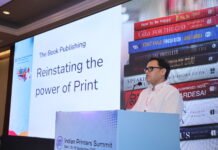At this year’s Jaipur Literature Festival, Correspondent Priyanka Tanwar interacted with Sandeep Unnithan, editor, News9 Plus and author of Black Tornado: The Three Sieges of Mumbai 26/11 and Operation X: The Untold Story of India’s Covert Naval War in East Pakistan on print journalism, the Covid-19 pandemic, circulation issues, subscription and ad revenues and military writing in India. Edited excerpts from the interview:
Indian Printer & Publisher (IPP) – How was your experience at the 16th edition of the Jaipur Literature Festival?
Sandeep Unnithan – Absolutely spectacular. This is my fifth Jaipur Lit Fest and I have had an amazing time. It’s so well-conducted, like a well-oiled machine. Just seamlessly segues from one session to the other. Happy to be here.
IPP – How did you become a journalist?
Sandeep Unnithan – I’ve been a journalist for 27 years now. I studied to be an archaeologist and as life’s happy coincidences and fate would have it, I kind of ventured into this field. So, I started training to be a journalist. I see a lot of similarity in these two professions because as a journalist, I’ve continued to excavate stories, exactly what I would be doing as an archaeologist. So in a sense, it’s destiny. I was always destined to excavate things and tell more interesting stories.
IPP – Tell us about your position at News9 Plus. Which categories are you covering?
Sandeep Unnithan – I’m editor of News9 Plus, a digital magazine. It’s the first of its kind in India and possibly in the world. We are like the Netflix of news. It’s an app that you can download. It’s something like India Today magazine, except that it’s in the digital domain. It’s a chance for a lot of journalists to reach out to a whole new demographic of consumers who are consuming news differently thanks to the OTT and digital India revolutions.
We have a complete range of categories from current affairs to news to foreign affairs, defense, sports, entertainment, lifestyle – what you would see in a print magazine. We feel there is a huge requirement for a video magazine in this category and that need hasn’t been fulfilled until now.
IPP – What impact did the Covid-19 pandemic have on journalism in India?
Sandeep Unnithan – The Covid-19 pandemic inflicted misery on the people. It affected everybody, rich or poor or influential or someone without any influence. It was a great leveler.
The other big learning was how we were more isolated in our spaces, but yet connected thanks to the digital revolution. You could be anywhere in India, but still be connected and lead virtual lives. You were working from home, which could not have been possible but for the digital revolution. I was at the India Today news magazine and for about the two years of the pandemic, we did not skip a single edition. We brought out over 100 issues of the magazine through the pandemic, the lockdowns, and the three waves of Covid-19. I think that was a big learning that there were different ways of doing what you were doing for several years. I feel it accelerated our move toward a digital future. What would have normally taken us, say, five or six years, happened in just about two years. The Covid-19 pandemic has brought the future closer to us.
IPP – How did the Covid-19 pandemic affect ad and subscription revenues?
Sandeep Unnithan – It devastated advertising revenue, there’s no doubt about it. It affected print in a very large way – print is a physical product, and depends on distribution. But when you are talking of lockdowns and containment zones, then this product can’t reach people — there’s a disruption. Then you have to find ways of either reaching it to people physically or reinventing yourself.
Reinventing as a digital product, sending it as a digital offering. We saw digital subscriptions going up. But I think the traditional model of advertising has been completely disrupted. I don’t think we’re going to go back to the golden age of print advertising that existed before 2019. In fact, even before 2019, that move away from print was already happening. The pandemic accelerated it. It’s going to be far more challenging for us as journalists to reinvent ourselves and to adapt to this new world.
I think it’s really important for us, because now for the first time, as content creators, as story writers, as journalists, we have to actually let our content speak for itself. We have to go out there and make sure our stories are of a quality that will make people want to pay for them. A lot of traditional print organizations are moving towards paywalls and a subscription-based model. I think that’s really good because that allows you to address the reader directly, without having to rely on advertisements, which kind of hold you hostage because you’re at the mercy of your advertisers. This is, I think, the best end statement when your reader is your patron. The reader, who you’re really writing for, decides whether you sell or you don’t sell.
IPP – How did the pandemic affect circulation?
Sandeep Unnithan – Circulation took a huge blow. In my housing society, I have spoken to two sets of people, both of whom are equally affected. The first set is the newspaper vendors, who have seen subscriptions literally crash. People have stopped buying newspapers and magazines. The printed word is not in circulation anymore like the way it was pre-2019. Even after the lockdown lifted, people weren’t going back to print. They preferred to get their news through electronic devices.
Then there is the newspaper waste dealer. He complains he’s not getting the kind of money he used to make simply because people aren’t buying newspapers the way they would pre-2020.
IPP – Do you think digital products can match the power of physical print?
Sandeep Unnithan – I think it’s a big challenge for us. It’s a whole new avenue for newspapers and magazines in the digital space. It allows us to tell stories in a very different kind of way. I’m not saying print is going to be completely eliminated. Print will always be there, but it’s going to be more like a very niche product, the way typewriters and fountain pens are still around despite the electronic advances we’ve made, or the fact that people have stopped writing the way they did in the past. These products would always be around as niche products. Print would never be mainstream the way it was some decades ago.
IPP – What got you interested in military writing?
Sandeep Unnithan – I think the fact that I came from a services background. That prepared me for the beat I would handle after I moved up from city reporting. There is a very basic outline of how you move up in a media organization. You start as a trainee reporter, move into city reporting, and then you look for specialization. What are you going to specialize in? Are you going to look at law, crime, defence, and political affairs? I chose defence as I thought it was the best thing for me to do. I’ve been doing it for about 16 years now, ever since I moved to Delhi from Mumbai, where I started my career.
IPP – Military writing has been doing well in India for the past decade. Your comments.
Sandeep Unnithan – Military writing is doing well, but unfortunately, we’ve not had the kind of military writers we need. I don’t see the kind of quality writing we should be seeing in the normal course of things like we see, for instance, in the West. You have an enormous body of military literature. You have young, talented, and gifted writers. Unfortunately, we’re not seeing that kind of writing in India. I have no clear answer why. One possible reason is that we, in the media, aren’t giving enough importance to the defense beat. Political debates and the economy occupy more mind space than the military. The military is seen as something that jumps into the headlines only when there’s a crisis on the border, or a war, or a near-war-like situation. Hopefully, these things will change.
IPP – What do you think is the problem behind this lack of military literature in India?
Sandeep Unnithan – It’s an interesting question because traditionally there’s been very little writing on the military. It was usually confined to military veterans who wrote books about themselves, and never any great military histories or battles. This was also not encouraged by the government because there was a certain narrative that wasn’t open to interpretation. Military histories were written, but they were not declassified. So, it was a kind of closed ecosystem. I think the media boom post-1991 opened up things and now we see more people like me writing and doing research on military history.
I’ve written two books, both are on military history. The first one was on the 26-11 attacks, which I saw unfold before my eyes (Black Tornado: The Three Sieges of Mumbai 26/11). The second was on the 1971 war (Operation X: The Untold Story of India’s Covert Naval War in East Pakistan), which happened before I was born. So the space is being reinvented but like I said, you don’t have enough writers. We have writers in the tens right now. I’d like to see military writers in the hundreds. We have a very rich and diverse tradition of military service. Very few militaries have seen the kind of deployments the Indian military has had over the last 120 years. There are plenty of stories to be told.
IPP – Recently two military literature festivals happened in Chandigarh and Lucknow. Your views.
Sandeep Unnithan – I think it’s a good thing. The more literature fests, the merrier. This beat needs a lot of support and such events could go toward that goal of popularizing military history. I believe we need a debate in society about the military. The military cannot be treated as an institution that’s away from the public glare. More than 15-16% of the government expenditure is on the armed forces, but there’s no debate on this in Parliament. Military reforms are never discussed. They are not political objectives for any political party. This kind of things, hopefully, would change if you would have a body of military writers, a citizenry that questions the way the military is being treated or the fact that reforms have not taken place. At the end of the day, we are a healthy democracy. Why should the military be kept out of this?
IPP – Would you like to talk about your book Operation X: The Untold Story of India’s Covert Naval War in East Pakistan?
Sandeep Unnithan – Operation X is a book I completed writing in 2019. I co-authored it with Captain MNR Samant, who participated in this operation in 1971. It had never been written about as extensively as we did in this book because it was a covert operation, which is not discussed by the state. These are operations the state can deny. Here you have what is possibly the first account written of an Indian covert operation by someone who was actually involved in the active planning.
All credit to Captain Samant who decided to come out and tell his story. It was just a beautiful coincidence that our paths converged and this two-year journey is what you see here in Operation X.
IPP – What role can publishers, independent booksellers and eCommerce sites play in the promotion of military literature?
Sandeep Unnithan – There is a huge interest in the Indian military among the people. You have a very large generation of people out there, young citizens who have seen the way, say, Hollywood writes about their military. There is a US military that’s in your face. They have movies and books written on them, their struggles have been immortalized on screen and in print. You have Indian audiences who ask, what about our stories? Who’s telling our stories? Where are the Indian military stories?
So, there is a huge hunger, interest and curiosity around Indian military stories. And that is a requirement that’s being filled in by publishers and by the military lit-fests that you just mentioned.
IPP – What about independent booksellers and eCommerce sites? How can they promote military literature?
Sandeep Unnithan – I think it would be a good idea for them to encourage more military writing and take on board more writers who can document aspects of Indian military operations or even the traditions and culture of the Indian military, like never before. The trick is to tell interesting stories. And that’s the very basic thing about why you are a writer or a journalist.
You want to tell interesting stories that connect with your audiences and your readers. It’s for them to figure this out because at the end of the day, we are all in the business of telling stories. The more interesting the stories are, the more they connect with the readers.
IPP – Do you think translating stories can work wonders for the book’s success?
Sandeep Unnithan – Yes, absolutely, because I think there is a huge demographic out there who are very comfortable in their native language. This is one of the reasons you see books being translated into vernacular languages. I have friends whose books were translated and widely circulated in Indian languages.
I’m waiting for that kind of Harry Potter revolution in the Indian publishing space when 20 years ago everyone said, ‘oh bookstores are dying’ and lo and behold, you have JK Rowling coming out with this fascinating series of Harry Potter books, which has captured the imagination of a whole new generation of readers. I hope the same thing happens for us in India as well.
IPP – What advice do you have for aspiring military writers?
Sandeep Unnithan – Go and read a lot, and spend time in the archives. Read a lot of military histories. Look for stories that haven’t already been told and find interesting ways of telling them. There are hundreds and thousands of stories waiting to be told to readers. There is a huge hunger for military writing they can hopefully fulfill.
IPP – Would you like to give a message to our readers?
Sandeep Unnithan – Patronize books. Read them in whatever form, whether print or digital. It’s only when you read our books that we feel inspired to write more and find new subjects for you to read.
IPP – Thank you for speaking with Indian Printer and Publisher.

















